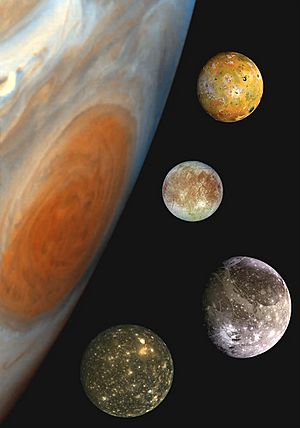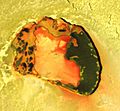Galilean moons facts for kids
The Galilean moons are the four largest moons that orbit the giant planet Jupiter. They were discovered by the famous scientist Galileo Galilei. These four moons are named Io, Europa, Ganymede, and Callisto. They are much bigger than Jupiter's many other moons.
Contents
How They Were Found
Galileo Galilei discovered the Galilean moons around late 1609 or early 1610. He had made great improvements to the telescope. Because of this, Galileo could see objects in space better than anyone before him. Using his new telescope, Galileo was the first to see four moons orbiting Jupiter.
On January 7, 1610, Galileo wrote a letter about Jupiter’s moons. At first, he only saw three of them. He thought they were just fixed stars close to Jupiter. He kept watching them from January 8 until March 2. During this time, he found a fourth object. He also realized that these four objects were not stars. Instead, they were orbiting Jupiter!
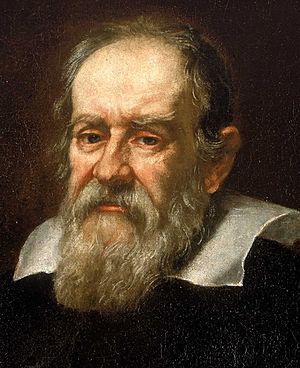
Galileo’s discovery showed how important the telescope was for astronomers. It proved there were many things in space that people could not see with just their eyes. More importantly, finding moons orbiting something other than Earth was a big challenge to the Ptolemaic world system. This old idea said that Earth was the center of the universe. It claimed that all other space objects revolved around Earth.
The fact that Jupiter had four moons, while Earth only had one, further weakened the belief that Earth was the most important place in the universe. Galileo wrote about his discoveries in a book called Sidereus Nuncius (which means Starry Messenger). He did not mention Copernicus's idea that the Sun was the center of the universe. However, Galileo himself believed in the Copernican theory.
Some historians say that a Chinese astronomer named Gan De might have seen one of Jupiter's moons in 362 BC. But without a telescope, it would have been very difficult to do this.
Naming the Moons
Galileo first called his discovery the Cosmica Sidera, meaning 'Cosimo's stars'. He named them after Cosimo II de' Medici, who was the grand-duke of Tuscany. Galileo wanted his support. Later, at the grand-duke's suggestion, Galileo changed the name to Medicea Sidera, or 'the Medici stars'. This honored all four Medici brothers. Galileo announced his discovery in his book Sidereus Nuncius, published in Venice in March 1610.
However, the names we use today were chosen by Simon Marius. Marius claimed he found the moons at the same time as Galileo. He named them after lovers of the Greek god Zeus (who is like the Roman god Jupiter). These names were Io, Europa, Ganymede, and Callisto. He published these names in his book Mundus Jovialis in 1614.
Galileo did not want to use Marius's names. Instead, he created a numbering system that is still used today, along with the proper names. The numbers go from the moon closest to Jupiter outwards. So, Io is I, Europa is II, Ganymede is III, and Callisto is IV. Galileo used this system in his notes but never published it.
The Galilean moons, from closest to Jupiter to farthest away, are:
| Name | Image | Interior structure |
Diameter (km) |
Mass (kg) |
Mean Density (g/cm³) |
Distance from Jupiter (km) |
Orbital period (days) |
|---|---|---|---|---|---|---|---|
| Io |  |
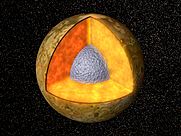 |
3643 | 8.93×1022 | 3.528 | 421,800 | 1.77 |
| Europa | 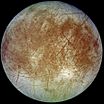 |
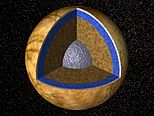 |
3122 | 4.8×1022 | 3.014 | 671,100 | 3.55 |
| Ganymede | 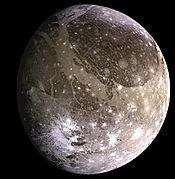 |
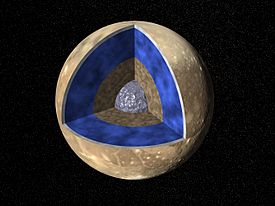 |
5262 | 1.48×1023 | 1.942 | 1,070,400 | 7.16 |
| Callisto | 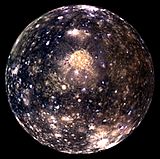 |
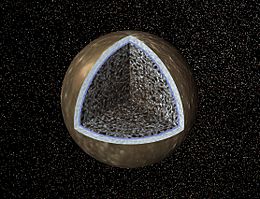 |
4821 | 1.08×1023 | 1.834 | 1,882,700 | 16.69 |
Seeing the Moons from Earth
All four Galilean moons are quite bright. If they were farther away from Jupiter, you could see them without a telescope. Their brightness is between 4.6 and 5.6 when Jupiter is in opposition (meaning Jupiter is on the opposite side of Earth from the Sun). They are a bit dimmer when Jupiter is in conjunction (meaning Jupiter is on the same side of Earth as the Sun).
The main reason they are hard to see is that they are very close to Jupiter. Jupiter's bright light makes them hard to spot. Their widest separation from Jupiter is between 2 and 8 minutes of arc. This is close to what the human eye can barely see. Ganymede and Callisto, when they are farthest from Jupiter, are the easiest to try and see without a telescope.
The easiest way to observe them is to block Jupiter's light. You can do this by using an object like a tree branch or a power line. Make sure the object is straight across the path of the moons' orbits.
Related pages
| The Solar System | |||||||
|---|---|---|---|---|---|---|---|
|
|
|||||||
| Sun • Heliosphere |
Planets ☾ = moon(s) ∅ = rings |
Mercury | Venus | Earth ☾ | Mars ☾ | ||
| Jupiter ☾ ∅ | Saturn ☾ ∅ | Uranus ☾ ∅ | Neptune ☾ ∅ | ||||
| Dwarf planets | Ceres | Pluto ☾ | Haumea ☾ | Makemake | |||
| Eris ☾ | |||||||
| Small Solar System bodies |
Asteroids (minor planets) |
Groups and families: Vulcanoids · Near-Earth asteroids · Asteroid belt Jupiter Trojans · Centaurs · Neptune Trojans · Asteroid moons · Meteoroids · Pallas · Juno · Vesta · Hygiea · Interamnia · Europa |
|||||
| See also the list of asteroids. | |||||||
| Trans- Neptunians |
Kuiper belt – Plutinos: Orcus · Ixion – Cubewanos: Varuna · Quaoar · Huya |
||||||
| Scattered disc: Sedna | |||||||
| Comets | Periodic comets and non-periodic comets Damocloids · Oort cloud |
||||||
| See also the list of solar system objects | |||||||
Images for kids
-
Two Hubble Space Telescope views of a rare triple transit of Jupiter by Europa, Callisto and Io (24 January 2015)
-
Comparison of (a part of) Jupiter and its four largest natural satellites
-
Jupiter with the Galilean moons – Io, Ganymede, Europa, and Callisto (near maximum elongation), respectively – and the full Moon as seen around conjunction on 10 April 2017
See also
 In Spanish: Satélite galileano para niños
In Spanish: Satélite galileano para niños


